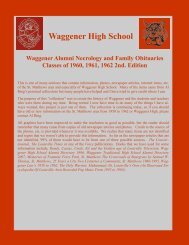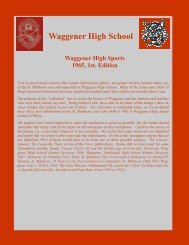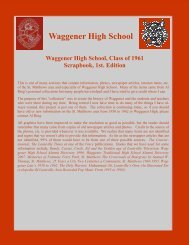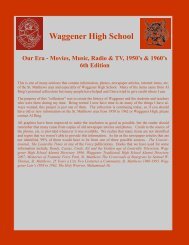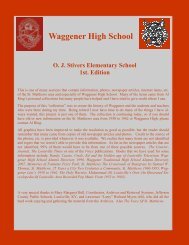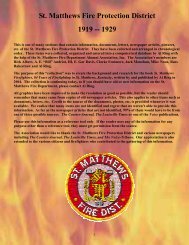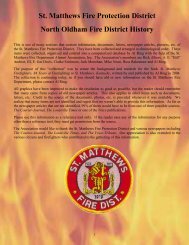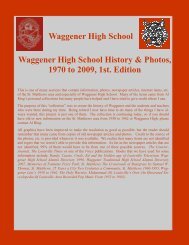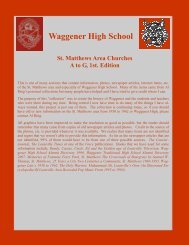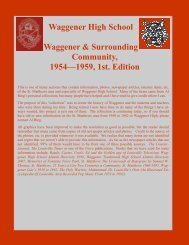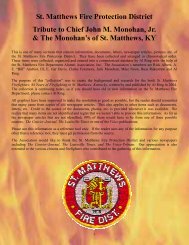The Voice of St. Matthews, January 12, 1956: Not Altogether Suburban After 1955St. Matthews Not Altogether Suburban After 1955In September, St. Matthews got a taste of what he meant. Eastern <strong>High</strong>’s enrollment was about 1,670 a 225 increase overthe previous year. Greathouse was down to 600 from 850 because of a shift of part of its population to the new St. MatthewsElementary, but <strong>Waggener</strong> Junior <strong>High</strong>, only in its second year, had 1,000 pupils jammed in a school built to ac<strong>com</strong>modateonly 850. Principal John Lowe announced that 125 of them would have to be taught part time at nearby St. Matthewselementary.The Jefferson County Municipal Conference representing 27 cities, pointed out that if all the taxes on autos and real estatewere collected properly it would mean an extra $2 million a year for City and County <strong>School</strong>s and City and County government,without a raise in rates. The inference was plain; collect the taxes you are entitled to now, before trying to get newones. The Louisville Real Estate Board echoed this argument in newspaper ads.But people in favor of the increase argued that the need was now, while it would take some time to reform tax collectionprocedures. The people of St. Matthews listened. Only 15 precincts in the County voted in favor of the increase in November,and all 15 were in the heart of St. Mathews. The County as a whole rejected it by a 2-to-1 majority.Greathouse <strong>School</strong> was saddened in February by the news that Kenneth Farmer, principal for almost 10 years, was leavingat the end of the term to be<strong>com</strong>e principal of the new Goldsmith Lane <strong>School</strong>. Miss Elizabeth Bennett, teacher at Greathousefor 10 years, was also slated to leave. She accepted the principalship at Eastwood <strong>School</strong>.Mr. Farmer was honored with a “This IS Your Life” program in May, and he and the departing Miss Bennett were givengifts of appreciation.In September another “old hand” left the <strong>com</strong>munity.Jack Dawson, principal at Eastern <strong>High</strong> since it opened in 1950, was named the first director of new buildings by theCounty Board of Education. Under his direction, Eastern had be<strong>com</strong>e one of the outstanding high schools in the state, bothacademically and athletically, and graduated a record class of 269 in June of 1955.The husky ex-football star was succeeded by his assistant, John Trapp. At Greathouse, 46 year-old Howard Shaver tookover, and Robert Neill, 30, was made principal of the new St. Matthews Elementary <strong>School</strong>.1955 will be remembered as the year that <strong>Waggener</strong> Junior <strong>High</strong>’s Band held its first spring concert, on April 29; that <strong>Waggener</strong>started it first newspaper, “Chit-Chat,” edited by Phoebe Keith and Connie Carter; that Stivers <strong>School</strong> opened its library;and that St. Matthews Elementary’s P.T.A. started work on that school’s library.For Eastern <strong>High</strong> <strong>School</strong> band it was a sensational year. Directed by Cecil Karrick, the band won the top honors at theSoutheastern ban Festival at Bristol, VA.In politics, it was a lively year in St. Matthews, just as it was throughout the state. Like all Kentuckians, the people of St.Matthews were interested in the <strong>com</strong>eback attempt of Happy Chandler, running for Governor, and many leading St. Matthewscitizens took an active part in the campaign.But of more immediate interest was the campaign for control of St. Matthews. Mayor James Noland and his George WashingtonParty had been running the City without political opposition for five years. Under the Mayor’s firm hand, the Cityhad advanced to a fourth-class status, had repaired streets, and provided police protection and fire and garbage service.Furthermore, in March of 1955, St. Matthews had defeated Louisville’s last effort to annex the St. Matthews business district,before a Circuit Court jury which ruled against Louisville by a 8-3 vote. This victory freed St. Matthews after a decadeof struggle with Louisville.Opposition in the form of the Community Party developed from three sources. First of all, the people living in the HubbardsLane-Westport sector were displeased with the rezoning by the City of the aforementioned tract of land owned by R.W. Marshall for use as a telephone maintenance center.Young Frank Mimms, who acted as attorney for this group in their unsuccessful attempt to defeat the rezoning, was placedat the head of the Community Party and ran against Mr. Noland for Mayor.Another group in the opposition consisted of men who had originally opposed incorporation of St. Matthews by MayorNoland and his Party.The third group was made up of people discontented with the administration for various reasons. Some of them were disturbedover the fact that two St. Matthews policemen had been indicted for rape in June, although charges were filed awayin October.The two parties maneuvered endlessly, and out of the two candidates for the Mayor’s part plus 12 candidates for Council.It seemed for a while only four or five would be allowed to remain on the ballot. But a decision by the Court of appealsplaced everyone on the ballot except three Community Party candidates for Council, and the voters had to write in theirnames.
The Voice of St. Matthews, January 12, 1956: Not Altogether Suburban After 1955St. Matthews Not Altogether Suburban After 1955Mayor Noland’s party had the support of nearly all the businesses of St. Matthews, plus the many citizens who appreciatedthe Mayor’s successful fight to keep St. Matthews from being annexed to Louisville unless the larger City showed itselfwilling and able to assume our liabilities and give immediate City services.In a heavy vote, about 2,000 of St. Matthews 3,300 eligible voters went to the polls, and the result was a resounding 2-to-1victory for Mayor Noland and his Party. With this mandate to govern and with this tribute to his won personal prestige, theMayor faced 1955 with the knowledge tht the overwhelming majority of the people were behind him and his council.Their problems of course, are not over.Two of the Community Party candidates for Council, Frank Stallings and “Buck” Tharp, had earlier filed a suit charging St.Matthews with collecting 1954 property taxes improperly. In June, 1955, Circuit Judge Macaulay Smith ruled against St.Matthews, saying the City had used improper assessment dates. The final decision is awaiting judgment by the court ofappeals.Two new sixth-class cities were incorporated here during the year—Woodlawn Park and Brownsboro Village.St. Matthews had earlier passed an ordinance proposing to annex the area between itself and Louisville. Brownsboro Villagewas in this area. But the people there wanted their own City and in January applied to Circuit Court for the right toincorporate.St. Matthews adhering to its policy of not annexing any territory where a majority of the people were unwilling, turnedBrownsboro loose, and incorporation was <strong>com</strong>pleted in February. Mortimer Goldsmith was elected Mayor by the Board ofTrustees.The same month, Woodlawn Park was incorporated. The little City lies between Westport Road and the L & N railroadtracks, east of Hubbards Lane. Appointed trustees were Burns Speer, Phil Perkins, John M. Owen, Woolsey Cavr, andJohn Kaster. The trustees elected Mr. Speer Mayor.An important development in February was final organization of the Jefferson County Municipal Conference, embracing27 Cities in the County, and the election as chairman of Mayor Earl Otis of Norbourne Estates.The Conference was the brain child of the St. Matthews Committee of Commerce, and its purpose was to find areas ofagreement between all the Cities in regard to <strong>com</strong>mon problems. The Conference came up with a six-point program to reformproperty tax collecting to produce about $2 million dollars extra in taxes without raising rates or assessments.The Conference’s revelation that these taxes were being lost annually in the City and County governments and the twoschool systems was damaging to the campaign to raise school taxes by 50 cents. Many voters thought that all taxes shouldbe collected before any new ones were levied.The attention of the Conference and of everyone else was turned in August to the sewer problem. A. P. Bell of the CitycountyHealth Department said that 48,000 homes in the County were using septic tanks. He warned that sewers wereneeded for these homes, for “septic tanks are not a permanent sewer disposal method,” but were only “temporary.” Hecalled present conditions a “health hazard,” and said in Beechwood Village, septic tanks effluent was running into the stormsewers.The problem was a tough one. The St. Matthews sewer district was serving more than 4,000 homes, and could not extendits lines eastward. The district announced it could not service Beechwood and other areas. Neither could the MetropolitanSewer District. By the end of the year, Beechwood was considering the possibility of building its own sanitary sewer system,but the cost will be so great, the project may be impractical.The local Government Improvement Committee suggested in December that Louisville annex all the urbanized areas of theCounty and that the Metropolitan Sewer District build sanitary sewers for those areas. A bill to allow the people to vote onthese issues is slated to be introduced in the 1956 session of the State legislature.Politically, St. Matthews displayed an attitude entirely opposed to that of the rest of the County and the state. Fifteen precinctsin the heart of the St. Matthews area voted for the school tax while the rest of the County rejected it.Happy Chandler won the democratic nomination for Governor but St. Matthews area Democrats voted against him. Mr.Chandler won the general election in the State by a record margin, and carried Jefferson County, but greater St. Matthewsgave his opponent Edward Denney a 9,226 to 5,047 majority.Only one Republican was elected to the Legislature. He was Representative Henry Heyburn of St. Matthews, who defeatedhis Democratic opponent, Clarence Hampton, 11,824 to 3,735.On the light side:
- Page 2 and 3: Explanation of the following pages,
- Page 4 and 5: The Voice of St. Matthews, April 20
- Page 6 and 7: The Voice of St. Matthews, April 20
- Page 8 and 9: The Voice of St. Matthews: July 17
- Page 10 and 11: The Voice of St. Matthews: Septembe
- Page 12 and 13: The Voice of St. Matthews, Septembe
- Page 14 and 15: The Voice of St. Matthews, Septembe
- Page 16 and 17: The Voice of St. Matthews, January
- Page 18 and 19: The Voice of St. Matthews, January
- Page 20 and 21: The Voice of St. Matthews:1955 Adve
- Page 22 and 23: The Voice of St. Matthews, May 5, 1
- Page 24 and 25: The Voice of St. Matthews, January
- Page 26 and 27: The Voice of St. Matthews, January
- Page 28 and 29: The Voice of St. Matthews, January
- Page 32 and 33: The Voice of St. Matthews, January
- Page 34 and 35: The Courier-Journal, October 20, 19
- Page 36 and 37: The Courier-Journal, October 20, 19
- Page 38 and 39: The Voice Of St. Matthews, January
- Page 40 and 41: The Voice Of St. Matthews, January
- Page 42 and 43: The Voice Of St. Matthews, January
- Page 44 and 45: The Voice Of St. Matthews, January
- Page 46 and 47: The Voice Of St. Matthews, January
- Page 48 and 49: The Voice Of St. Matthews, January
- Page 50 and 51: The Voice Of St. Matthews, February
- Page 52 and 53: The Voice Of St. Matthews, July 18,
- Page 54 and 55: The Voice of St. Matthews, August 1
- Page 56 and 57: The Voice of St. Matthews, August 1
- Page 58 and 59: The Voice of St. Matthews, January
- Page 60 and 61: The Voice of St. Matthews, January
- Page 62 and 63: The Voice of St. Matthews, January
- Page 64 and 65: The Voice of St. Matthews, January
- Page 66 and 67: The Voice of St. Matthews, January
- Page 68 and 69: The Voice of St. Matthews, January
- Page 70 and 71: The Voice of St. Matthews, January
- Page 72 and 73: The Voice of St. Matthews, April 2,
- Page 74 and 75: The Voice of St. Matthews, July 16,
- Page 76 and 77: The Voice of St. Matthews, July 16,
- Page 78 and 79: The Voice of St. Matthews, July 16,
- Page 80 and 81:
The Voice of St. Matthews, July 16,
- Page 82 and 83:
The Voice of St. Matthews, July 16,
- Page 84 and 85:
The Voice of St. Matthews, July 16,
- Page 86 and 87:
The Voice of St. Matthews, July 16,
- Page 88 and 89:
The Voice-Jeffersonian, April 9, 19
- Page 90 and 91:
The Voice-Jeffersonian, April 9, 19
- Page 92 and 93:
The Voice-Jeffersonian, April 9, 19
- Page 94 and 95:
The Voice-Jeffersonian, April 9, 19
- Page 96 and 97:
Jim Herron Collection:L & N St. Mat
- Page 98 and 99:
The Voice, July 25, 1974:Reading it
- Page 100 and 101:
The Voice, July 25, 1974:25th Anniv
- Page 102 and 103:
The Voice, July 25, 1974:falling li
- Page 104 and 105:
The Voice, July 25, 1974:Under Ogle
- Page 106:
The Voice, July 25, 1974:25th Anniv



